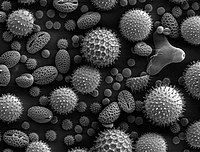
Photo from wikipedia
Purpose of review Local allergic rhinitis (LAR) is a recently classified subtype of rhinitis defined by a nasal allergic response in patients without systemic evidence of atopy. Recent studies have… Click to show full abstract
Purpose of review Local allergic rhinitis (LAR) is a recently classified subtype of rhinitis defined by a nasal allergic response in patients without systemic evidence of atopy. Recent studies have reported the prevalence, clinical course, culprit allergens, diagnostic methods and treatment outcomes of LAR. The purpose of this review is to summarize the most relevant and updated scientific evidence for LAR, especially focusing on its prevalence and clinical characteristics. Recent findings LAR is found in a significant proportion (3.7–61.9%) of patients previously diagnosed with nonallergic rhinitis, but the prevalence may differ among ethnic groups and countries. Common allergens of LAR are similar to those of allergic rhinitis, in which house dust mites are the most common cause, followed by grass pollen, tree pollen, weed pollen and animal dander confirmed by provocation tests. Although the nasal provocation test to a single allergen is considered the gold standard method, the detection of allergen-specific IgE and other inflammatory mediators from nasal secretions and the basophil activation test can assist in the diagnosis of LAR. Conjunctivitis and asthma are the most common comorbid conditions, and the occurrence rate of asthma increases over period. However, the conversion rate to allergic rhinitis was not significantly different between LAR and healthy controls. Summary LAR is a well-differentiated entity of rhinitis, which should be considered in patients with persistent and severe symptoms without any systemic evidence of atopy. Further research is needed to investigate the long-term outcome, and geographic and ethnic differences of LAR.
Journal Title: Current Opinion in Allergy and Clinical Immunology
Year Published: 2018
Link to full text (if available)
Share on Social Media: Sign Up to like & get
recommendations!